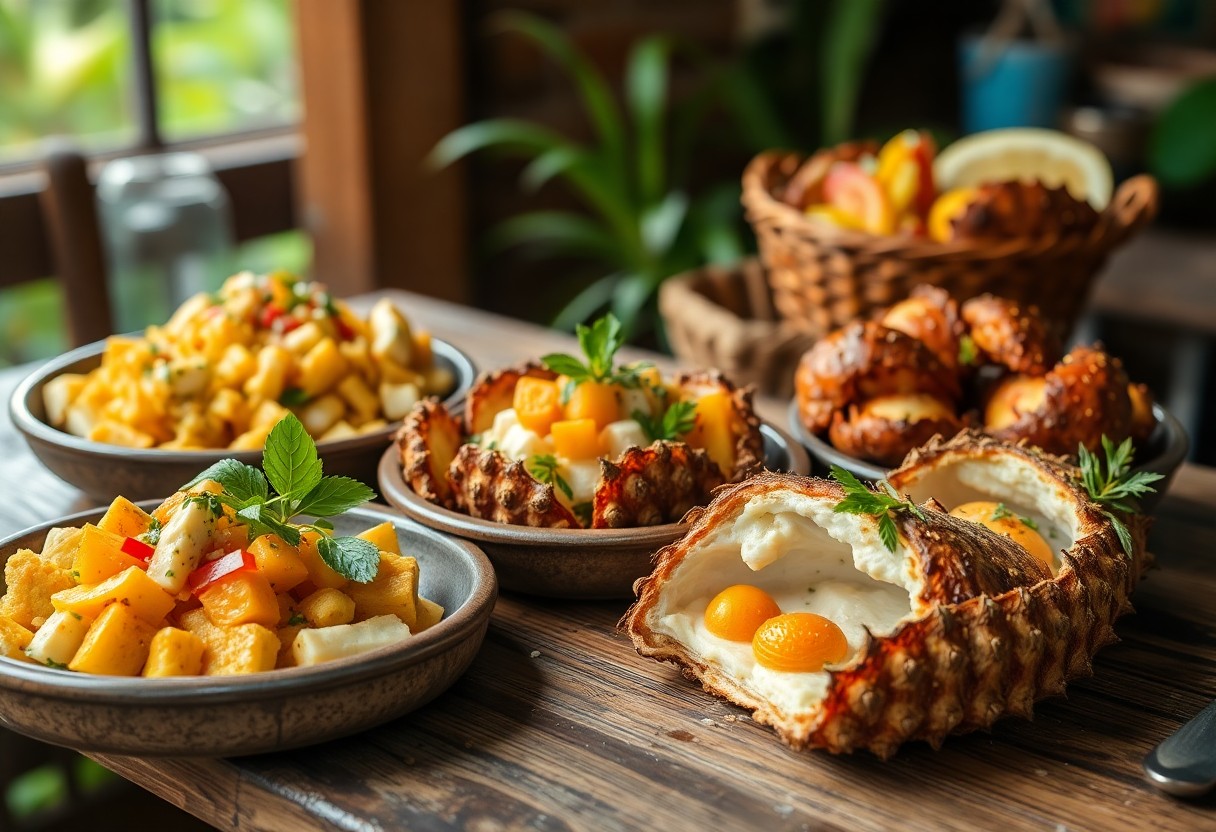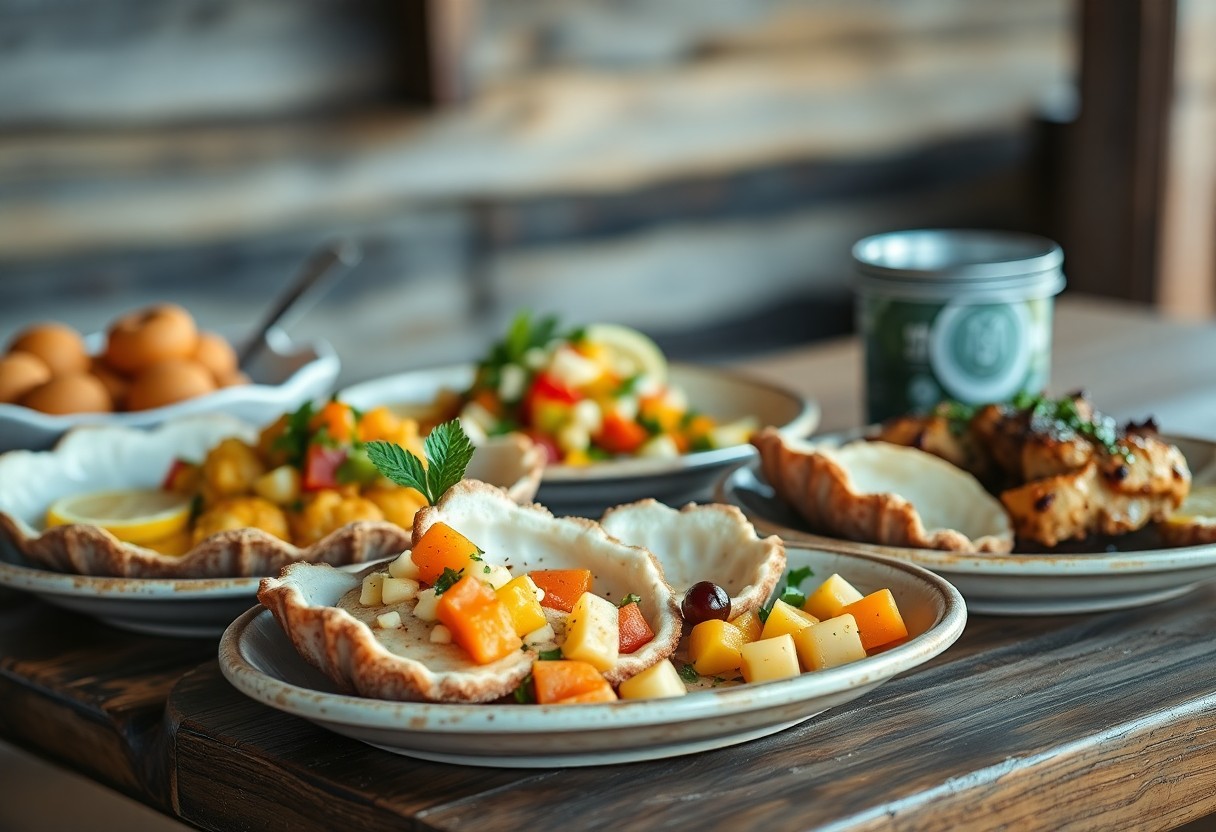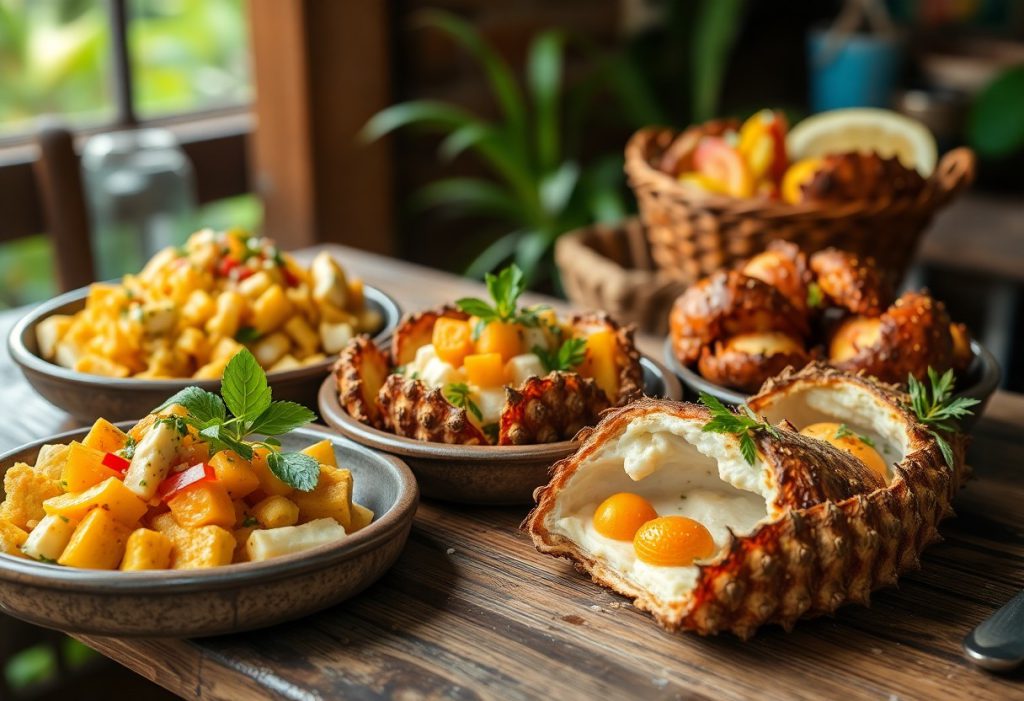The arrival of Conch season heralds one of the most anticipated culinary experiences along the Caribbean coastline, inviting you to embark on an exciting gastronomic journey! This highly prized seafood delicacy, Queen Conch, offers a distinctive blend of sweet and tender meat that is transformed into a variety of mouthwatering dishes by talented local chefs. Across the islands, you’ll find an impressive range of preparations for these marine mollusks, from fresh and raw selections to expertly cooked dishes. Your culinary adventure begins with locally sourced, sustainable catches provided by certified vendors. Before indulging in these exquisite treats, it’s vital to familiarize yourself with the local fishing regulations and seasonal restrictions to ensure responsible consumption of this protected species.

Unveiling the Allure of Queen Conch: A Culinary Treasure
The Queen Conch (Strombus gigas) is a large marine mollusk that thrives in the warm, inviting waters of the Caribbean Sea. This protected species has become a cultural icon within Caribbean cuisine, renowned for its striking pink shell and the highly coveted meat that delivers a remarkable array of flavors. Beyond its role as a food source, the conch embodies a rich tradition and heritage, making it an essential component of local culinary identity and a symbol of cultural pride.
Understanding the Key Features and Seasonal Availability of Conch
In Belize, the Queen Conch you encounter is harvested during the legally designated season from October 1 to June 30. This period presents the best opportunity to spot these fascinating creatures in shallow waters, where they actively graze on seagrass and algae. The conch meat is characterized by a firm texture and a delicate, sweet flavor profile, making it a perfect ingredient for a wide range of culinary creations. Gaining insight into the life cycle and habitat of Queen Conch will deepen your appreciation for this extraordinary seafood and its significance in local cuisine.
Discovering the Nutritional Power of Queen Conch
A modest serving of conch meat offers your body a wealth of high-quality protein and essential nutrients. Consuming conch provides you with significant amounts of vitamin B12, iron, and magnesium, all while keeping calorie intake low. Notably, the meat is naturally low in fat and packed with lean protein, making it an excellent choice for health-conscious diners eager to enjoy delicious flavors without compromising on their dietary goals.
Moreover, conch meat boasts nutritional benefits beyond simple sustenance. A mere 3-ounce serving can fulfill a considerable portion of your daily protein requirements, delivering approximately 22 grams of protein. Additionally, this seafood is a source of omega-3 fatty acids, which contribute to heart health, alongside minerals like selenium and vitamin E, both of which play a crucial role in supporting a robust immune system.
Diving into the Diverse and Delicious Queen Conch Dishes
Prepare to explore the variety of delectable ways to enjoy Queen Conch within local culinary traditions. From fresh raw delicacies to expertly cooked meals, each dish showcases the unique sweet-salty flavor profile that makes this seafood so highly regarded. Your culinary exploration through these various preparations will reveal why Queen Conch is a staple in Caribbean gastronomy, delighting your taste buds with every bite.
Experiencing Authentic Flavors with Traditional Conch Preparations
If you’re eager to savor authentic conch cuisine, your journey should start with conch ceviche and conch fritters. These traditional recipes have been lovingly passed down through generations, encapsulating the essence of Caribbean flavors. You can find these delightful dishes featured in local restaurants and beachside eateries throughout Belize during the official conch season, from October 1 to June 30, making them an essential experience for any food enthusiast.
Innovative Dishes Elevating Conch to New Heights
Modern chefs are reinventing traditional conch recipes, transforming them into exciting new culinary experiences. Today, you can indulge in conch tacos, conch pasta, and even creative conch sushi rolls. These innovative dishes maintain the seafood’s inherent flavors while introducing contemporary culinary twists that invigorate the palate and elevate your dining experience.
To further enhance your meal, many local restaurants now offer fusion dishes that skillfully blend Caribbean flavors with inspirations from international cuisines. You can enjoy conch spring rolls, conch wontons, and conch bruschetta, all of which showcase the versatility of conch while honoring its delicate texture and taste.

Mastering Essential Techniques for Preparing Queen Conch
Once you have sourced fresh Queen Conch, mastering proper preparation techniques is essential for creating mouthwatering dishes. Here are some vital steps to follow:
- Carefully extract the conch from its shell using a hammer and chisel to minimize damage.
- Thoroughly clean the meat to ensure the removal of any dark skin and internal organs that could affect flavor.
- Score the meat in a cross-pattern to enhance absorption of seasonings and marinades.
- Utilize a meat mallet to tenderize the conch until it achieves a pliable texture.
Although proper preparation can be time-consuming, following these steps is crucial for ensuring the best texture and flavor in your culinary creations.
Effective Cleaning and Tenderizing Techniques for Optimal Flavor
Even novices to conch preparation can achieve excellent results with the right methods. Start by washing the meat in saltwater to eliminate impurities, then carefully remove any remaining dark spots. For tenderizing, you can either use the traditional method of pounding with a mallet or opt for the modern approach of using a food processor for quicker results. Properly tenderized conch should feel flexible without becoming mushy, ensuring a perfect cooking experience.
Guidelines for Storing and Preserving Your Conch
Proper storage is a crucial aspect of conch preparation that should not be overlooked. Fresh conch needs to be refrigerated at 40°F (4°C) and consumed within three days, or it can be frozen for up to six months. It’s vital to tightly wrap the meat in plastic wrap or place it in an airtight container to maintain its freshness and prevent freezer burn.
To optimize preservation, consider these tips: never refreeze thawed conch, always pat the meat dry before storage, and divide it into portion-sized packages prior to freezing. For the best quality, vacuum-sealing portions and labeling each package with the storage date can help; maintaining frozen conch at 0°F (-18°C) or lower will keep it fresh for an extended duration.
Step-by-Step Cooking Techniques for Perfectly Prepared Conch
Many conch dishes require meticulous preparation steps to ensure both flavor and food safety. It’s essential to clean and tenderize the conch thoroughly before beginning the cooking process to achieve optimal results.
| Step | Description |
|---|---|
| Cleaning | Carefully remove the membrane and clean thoroughly |
| Tenderizing | Pound the meat until it reaches the desired tenderness |
Foundational Methods for Preparing Conch Successfully
Cooking conch begins with proper cleaning. Wash the meat thoroughly in saltwater to remove impurities and dark spots that could affect the taste. After cleaning, tenderize the meat effectively by pounding it until it achieves the desired softness for cooking.
Advanced Techniques for Cooking Conch to Achieve Perfection
- Score the meat using a crosshatch pattern to enhance flavor absorption.
- Marinate for at least 2 hours to maximize flavor infusion.
- Cook at medium-high heat for optimal results and texture.
| Cooking Method | Recommended Temperature |
|---|---|
| Frying | 350°F |
| Grilling | 400°F |
With the right techniques, you can create tender and flavorful conch dishes. Remember that overcooking can lead to tough meat, so it’s crucial to monitor cooking times closely for best results.

Identifying the Key Factors Influencing Queen Conch Quality
It’s essential to recognize that several factors determine the quality and flavor of your Queen Conch. These factors include:
- Water temperature
- Harvesting depth
- Handling methods
- Storage conditions
Understanding these elements will guide you in selecting the finest conch for your culinary endeavors, ensuring a delightful dining experience.
The Impact of Harvesting Conditions on Conch Quality
It’s critical to understand that proper harvesting significantly influences the quality of conch. Conch harvested from depths of 20-30 feet typically yields the best meat texture. Generally, conch caught from clean, cool waters produces superior-tasting meat with a firmer consistency, enhancing your culinary experience and flavor enjoyment.
Criteria for Selecting the Finest Queen Conch
When selecting Queen Conch, it’s crucial to pay attention to specific indicators. Look for clear, bright shells with undamaged edges. The meat should emit a fresh ocean scent and possess a pinkish-white hue. Additionally, the conch should feel firm to the touch, avoiding any slimy or mushy textures that indicate spoilage.
By recognizing quality indicators, you can make informed choices when selecting conch. Aim for shells measuring at least 7 inches in length, which signifies mature conch. Avoid specimens displaying dark spots or discoloration on the meat. The lip of the shell should be fully flared and thick, indicating it has been harvested legally. Lastly, ensure that the chosen conch has meat that feels elastic when pulled, indicating freshness and quality.
Assessing the Pros and Cons of Different Cooking Methods for Conch
Unlike other seafood, Queen Conch requires specific preparation methods to achieve the ultimate taste and texture in your dishes. The choice of cooking technique can profoundly influence the flavor profile and nutritional value of the final product.
| Pros | Cons |
|---|---|
| Raw (Ceviche): Preserves nutrients and fresh taste | Requires very fresh conch for safety |
| Frying: Quick preparation and crispy texture | Higher fat content due to frying |
| Steaming: Retains moisture and tenderness | Can become chewy if overcooked |
| Grilling: Enhances flavor through charred notes | Risk of drying out if not monitored |
| Stewing: Tenderizes meat through slow cooking | Longer cooking time required |
Advantages of Traditional Cooking Techniques for Conch
Utilizing traditional cooking methods for conch offers benefits such as enhanced flavor development and a tender texture. Slow-cooking techniques, often handed down through generations, effectively break down tough fibers in the meat, resulting in a more digestible and flavorful dish that pays homage to cultural culinary practices.
Benefits of Modern Cooking Techniques to Elevate Conch Dishes
Modern cooking methods provide quick and efficient options for preparing conch, allowing for precise temperature control and consistent results. With these advanced techniques, your conch dishes can be prepared in a shorter time frame while still preserving their nutritional value through methods like flash-frying and pressure cooking.
Furthermore, modern preparation techniques enable you to maintain freshness through vacuum sealing and blast freezing, extending the shelf life of conch while ensuring that food safety standards are meticulously upheld throughout the process.
Embarking on a Flavorful Culinary Adventure with Queen Conch
Ultimately, your culinary exploration of Belize’s Queen Conch season offers you the chance to indulge in three standout dishes until June 30. Relish crispy conch fritters from local vendors, savor fresh ceviche on boat tours, and enjoy warming conch stew in traditional restaurants. Each dish provides a unique taste of Belizean seafood culture. As you plan your visit, be sure to sample these local favorites to fully appreciate the rich flavors of Belize’s coastal cuisine. The straightforward preparation methods and high-quality ingredients will ensure that your dining experience is truly unforgettable.
Your Questions Answered: Comprehensive FAQ on Queen Conch
Q: What are the official dates for Queen Conch season in Belize?
A: The Queen Conch season in Belize is officially designated from October 1st to June 30th. During this time, you can enjoy a wide array of fresh conch dishes available at restaurants, local diners, and street vendors throughout the country.
Q: What ingredients typically make up Belizean conch fritters?
A: Belizean conch fritters are crafted using diced conch meat mixed with onions, sweet peppers, garlic, herbs, and habanero peppers for a delightful kick. These ingredients are blended into a batter and fried until they achieve a golden, crispy texture that is truly irresistible.
Q: How is traditional Belizean conch ceviche prepared?
A: Traditional Belizean conch ceviche is made by dicing fresh conch meat and soaking it in lime juice. The marinated conch is then combined with tomatoes, onions, and cilantro, with optional additions like carrots or cucumbers. The dish is seasoned with black pepper and salt, served alongside Belizean tortilla chips for a delightful and refreshing experience.
The Article Queen Conch Season is Here: Must-Try Local Delicacies! appeared first on Belize Travel Guide
The Article Queen Conch Season: Savor These Local Delicacies! Was Found On https://limitsofstrategy.com



The allure of Queen Conch truly reflects the intersection of culture and cuisine along the Caribbean. I recently experienced a conch festival in the Bahamas, where local chefs showcased everything from conch fritters to conch salad, each dish steeped in tradition and creativity. It was fascinating to see how different islands interpret the same ingredient, highlighting the diversity of Caribbean culinary practices.
It sounds like you had an incredible experience at the conch festival in the Bahamas. The way food intertwines with culture is always fascinating, and conch seems to be a perfect example of that in the Caribbean. I’ve always loved how every island has its unique twist on traditional ingredients – it really showcases not just culinary creativity but the stories and traditions that come with them.
The experience you shared at the conch festival in the Bahamas truly captures the essence of Caribbean culture and cuisine. It’s incredible how food can serve as a bridge connecting people to their history and traditions. Conch, in particular, is more than just an ingredient; it’s a symbol of the vibrant marine life surrounding the islands, and it plays a crucial role in the local economy and identity.
I completely resonate with the excitement surrounding the arrival of Conch season! There’s something uniquely special about indulging in local seafood that embodies the flavors and culture of the Caribbean. As you mentioned, the Queen Conch, with its sweet and tender meat, becomes a versatile centerpiece in many dishes, each reflecting the creativity and culinary heritage of the region.
I appreciate your take on Conch season. It really is a celebration of flavors, isn’t it? The way Queen Conch can be prepared — from fritters to salads — showcases just how versatile it truly is. It’s fascinating how different islands have their own unique twists on traditional recipes that bring their local culture to life.
The excitement surrounding Queen Conch season truly resonates with those of us who cherish the unique flavors and cultures of the Caribbean. Each bite of this delicacy tells a story—not just of the sea, but of the communities and traditions that celebrate it. I remember my first experience savoring conch fritters on a little beachside shack in the Bahamas, where the locals passed down their recipes through generations. It’s fascinating how food can serve as a bridge between cultures and evoke such cherished memories.